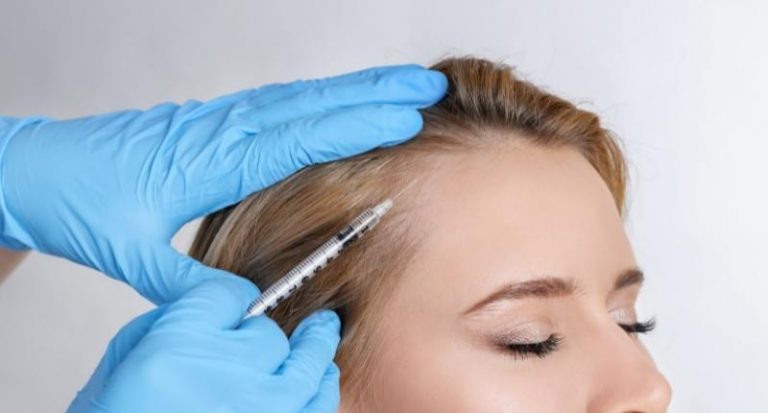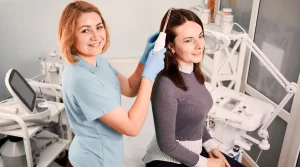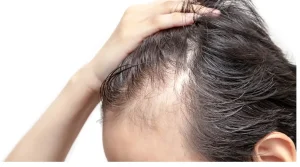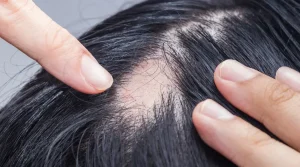Hair loss is a common problem that affects both men and women.
It is caused by many factors, some of which are beyond our control. However, there are treatments for hair loss available to help those who suffer from it.
One such treatment is Platelet-Rich Plasma (PRP). It has been proven to be an effective treatment for those who have lost their hair due to chemotherapy or alopecia areata, and it promises to grow back the hair within just a few months.
This article will teach you everything you need to know about PRP therapy for hair loss including how it works, what’s involved in the process, and why we think it might be worth trying out if you’re struggling with thinning locks!
What is Platelet-Rich Plasma Treatment for Hair Loss
Platelet-rich plasma (PRP) is a type of therapy that involves extracting the patient’s blood, then spinning it in a certain way with a centrifuge. This separates out some white blood and platelets from the blood, then injects it back into the scalp and roots.
These platelets contain proteins that are responsible for the creation of growth hormones, anti-inflammatory substances, fatty acids, and vitally important micronutrients.
This helps repair hair because platelets release proteins that are important for healthy hair growth and cellular regeneration. These proteins trigger stem cells into action, which ultimately blast off molecules as they replicate again and again.
Is it Effective and Who Is a Candidate?
The use of Platelet-Rich Plasma (PRP) to treat hair loss continues to grow in popularity. One study found that injections of the protein helped increase growth and reduce baldness in 262 participants who suffer from a condition called Androgenetic Alopecia (AGA). The study was published in 2019 by the Aesthetic Plastic Surgery Journal.
Although scientists are still unsure as to the effectiveness of PRP injections, they hope that soon there will be a standardized protocol for injecting it.
Who is a candidate for PRP?
PRP therapy is a long-term treatment for hair loss and is not meant to be used as an immediate replacement. Those with lupus, thyroid diseases, or other underlying disorders are less likely to experience success because these conditions can cause the condition of their alopecia may continue without any relief from PRP Therapy.
The clinic performing the treatment will carefully review your medical history before determining if you’re eligible for this procedure which requires that patients maintain good overall health.
One must avoid specific types of skin issues, blood and liver problems, and diabetes. Certain medications also impact one’s ability to undergo PRP Therapy so it’s vital they discuss all medication-related concerns beforehand during consultation time in order to avoid errors on behalf of both parties when conducting treatments.
People who have experienced chemotherapy or alopecia areata may also be good candidates for PRP treatment because it encourages new hair to grow back.
If you are interested in trying out a new treatment for hair loss, your doctor can test your blood to see if you’re a candidate.
Potential Side Effects and Risks
PRP has been found to have a positive effect on male and female pattern hair loss without major adverse side effects.
You may experience minimal pain, pinpoint bleeding, and redness when the injections are being delivered but these are side effects of the delivery method, not on the therapy itself.
Doctors note that patients often comment on a “full” feeling in their scalp immediately after injection or mild tenderness which can last up to 1 day. Rarely some will also complain of headaches later day.
It is important to note that not everyone who undergoes PRP therapy will have success. It’s a long-term treatment and the results are seen months after it has been done, so if patients don’t see any response within three or more months then they should speak with their doctor about other options.
One major potential side effect of this therapy is scalp infection. Patients may experience a few days of redness and swelling following injections, but this will go away with time.
Frequently Asked Questions about Platelet-Rich Plasma Treatment for Hair Loss:
How does Platelet-Rich Plasma work?
The process of PRP treatment is said to be incredibly simple. The doctor will take a pint or so (a typical amount) of blood from the patient and use an automated machine to spin it in order to separate out the platelets, which contain proteins responsible for hair growth and cellular regeneration.
How long does the process take?
Typically, a patient will have to go back for one or two more sessions six to eight weeks apart before they notice any results. It’s important that patients don’t stop treatment midway through because it takes time for hair follicles to respond.
How much does PRP Treatment cost?
PRP treatment is costly, so it’s often not covered by insurance. It costs between $500 and $2,000 depending on the location of where you get PRP injection as well as facilities that are used for the procedure.
A person can expect to have multiple injections given 2-3 months apart with each visit costing a different amount because sometimes one facility will be more expensive than another but offer better support or amenities during recovery time following the appointment.
How long will I have to wait before seeing results?
One should expect to have hair growth within three months or following the PRP treatment. Results will not show up immediately, but patience is key in order to see results.
What are the benefits?
PRP treatment may be beneficial for those who suffer from a type of hair loss called male pattern baldness or female pattern thinning, but it is also useful in repairing other scalp conditions such as alopecia and scarring from injury or surgery.
Where can I get Platelet-Rich Plasma Therapy?
This treatment is not available in every location, so you will need to contact your doctor or a clinic that offers this procedure for more information about whether they perform it and what protocols are involved to determine if you’re eligible.
Conclusion
Platelet-Rich Plasma (PRP) therapy for hair loss is still in its experimental stages with many risks and side effects. However, there are potentially some significant benefits such as new hair growth or halting baldness. One must have a good physical condition before undergoing this treatment since it’s not meant to be a cure for baldness. The long-term benefits depend on how many injections a person has done, so it’s important to speak with your doctor about what the risks and potential rewards are before committing.





